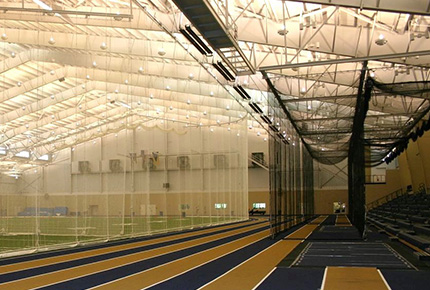
Selecting the best athletic netting for your sports facility requires some consideration. It’s important to review your location constraints, level of play, weather conditions and sports regulations.
Identify Potential Hazards and Risks
Spectator and player safety is paramount. Athletic netting must be strong enough to stop balls, discs and other projectiles from harming anyone in the crowd or damaging property. Baseball, golf and ice hockey netting provide barrier coverage that also protects players from ricocheting objects and items from the crowd.
Consider the crowd’s proximity to the action and how fast projectiles can travel if they go out of bounds. You’ll also need to protect interior and exterior scoreboards, equipment and residential properties.
Determine Netting Material and Construction
The thicker the twine diameter, the greater the net strength. That increases a net’s ability to slow and stop flying objects without too much fiber flexing or movement. The mesh size is determined by the size of the ball or object used during play.
For example, golf netting should have a finer, smaller mesh to prevent golf balls from passing through the barrier. Football netting can have larger mesh openings that are still effective at containing balls.
There are different types of sports netting materials, including:
- Nylon
- Polyester
- Polypropylene
- Kevlar
- Steel
- Plastic
Consider Indoor and Outdoor Factors
Environmental factors will influence your netting material selection. Nylon is good for indoor sports facilities and can withstand heavy use. Polyester is a UV-resistant fiber that tolerates extreme temperatures without breaking down. Polyethylene is suitable for indoor and outdoor sports netting due to its high tensile strength.
Indoor sports netting factors include:
- Height and width of the space
- Lighting
- Ventilation and airflow
- Installation and maintenance requirements
Consider the following for outdoor sports netting systems:
- UV resistance
- Waterproofing
- Weather variations
- Installation and anchoring
- Visibility
- Cleaning requirements
Assess Durability and Longevity
Durability is essential for sports netting, especially if it’s installed around high-impact activities like football and soccer. Investing in the right athletic netting system can provide long-term cost savings. While it may be more expensive, buying durable netting reduces sports netting maintenance needs and costs.
The environment, temperature and weather can affect a net’s integrity by making it brittle or loose. Try a material like high-density polyethylene to ensure your athletic netting withstands extended outdoor use without fraying or discoloration.
Evaluate Visibility
A good view allows audience members to connect with the action and stay engaged. Athletic netting must provide security, but not so much that it obstructs visibility. Smaller mesh might make it difficult to see, but larger openings could decrease ball containment. You must weigh those factors to determine what type of sports netting is best for attendees.
Sports netting color can improve visibility by enhancing contrast against background environments. Light-colored netting is easier on the eye and less likely to obstruct someone’s line of sight.
Sports Netting from Tiffin Scenic Studios
Whether you’re preparing for an upcoming sports season or in the middle of one, Tiffin Scenic can create innovative netting solutions for your athletic facility. Contact our team to learn about our inspection and installation services.